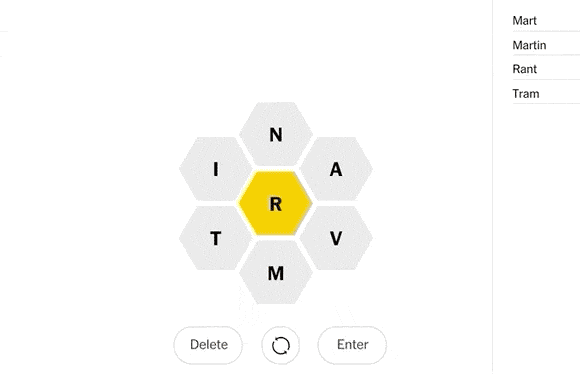NYT Spelling Bee
One of the most popular word games!
The New York Times Spelling Bee game has captivated word puzzle enthusiasts since its digital launch, transforming a simple concept into a daily ritual for thousands. In this comprehensive guide, we delve into the history, gameplay mechanics, statistics, strategies, and more surrounding the NYT Spelling Bee game.
What is the NYT Spelling Bee Game?
The NYT Spelling Bee is a word puzzle game published daily by The New York Times. It challenges players to make as many words as possible using seven given letters arranged in a honeycomb pattern. Each puzzle has one mandatory center letter that must be used in every word.
Words must be at least four letters long, and each word must include the center letter. Points are awarded based on word length and difficulty, and there is always at least one pangram — a word that uses all seven letters.
History of the NYT Spelling Bee
Although the digital version of the NYT Spelling Bee debuted in 2018, its roots trace back to the print edition of The New York Times Magazine. It first appeared in the late 2000s as a weekly puzzle.
The digital iteration, developed under the leadership of Sam Ezersky, NYT’s Associate Puzzle Editor, introduced daily puzzles and a more interactive, gamified experience. Since then, it has gained a massive online following, particularly during the COVID-19 pandemic, when people sought home-based brain games.
How to Play
- Access the Game: Visit NYT Spelling Bee or use The New York Times app.
- Letter Grid: The honeycomb grid includes 7 letters — 6 surrounding a central required letter.
- Form Words: Create words using the letters. All words must be at least four letters and include the central letter.
- Scoring:
- 4-letter words: 1 point
- Longer words: 1 point per letter
- Pangram: Bonus of 7 points or more, depending on length
A typical game has around 25–75 acceptable words and one or more pangrams.
Ranks and Scoring Titles
The game assigns a title based on your score. These rankings provide motivation and a sense of achievement:
- Beginner
- Good Start
- Moving Up
- Good
- Solid
- Nice
- Great
- Amazing
- Genius
Reaching the Genius level is often the ultimate daily goal for players. Those who find all possible words are awarded the title Queen Bee.
Why the NYT Spelling Bee is So Popular
- Accessibility: Anyone can play with just a smartphone or browser.
- Daily Challenge: A fresh puzzle is released every day at 3 a.m. ET.
- Gamification: Point systems and ranks encourage daily participation.
- Educational Value: Expands vocabulary and improves spelling.
- Social Sharing: Players share their scores and pangram discoveries on social media, fostering community.
Key Statistics and Facts
- User Base: As of 2023, the NYT Spelling Bee had over 1 million daily players.
- Most Common Letters: The letter "E" is the most frequently used center letter.
- Average Words per Puzzle: Between 30 and 60.
- Average Pangrams: Usually 1-2 per puzzle, though some have up to 4.
- High Scores: Some puzzles have possible scores over 400 points.
Strategies to Improve Your Game
- Start with Common Prefixes and Suffixes: -ing, -ed, re-, un-, etc.
- Look for Compound Words: Combining short words can reveal longer ones.
- Shuffle Letters: This simple action often sparks new word discoveries.
- Use a Word List: Familiarize yourself with valid Spelling Bee words (no proper nouns or hyphenated terms).
- Pangram Hunt: Always keep the pangram in mind — it’s usually a longer word with a balanced distribution of letters.
Famous Puzzles and Memorable Moments
- March 15, 2020: The puzzle had three pangrams, an unusually high number.
- April 10, 2021: Featured the word "vaccinate," drawing attention for its timeliness.
- December 25, 2022: Christmas Day puzzle had thematic words like "sleigh" and "gift."
Behind the Scenes: Sam Ezersky
Sam Ezersky is the mastermind behind the game’s daily creation. He handcrafts each puzzle to balance difficulty, letter variety, and word richness. He often includes obscure but valid words, leading to the phrase: "Blame Sam" when players find an especially tough word.
Ezersky studied computer science and linguistics and joined NYT Games early in his career. His editorial insights ensure that each Spelling Bee puzzle maintains educational and entertainment value.
Community and Culture
The NYT Spelling Bee has inspired:
- Reddit Threads: r/NYTSpellingBee offers hints, spoilers, and camaraderie.
- Twitter Hashtags: #SpellingBee, #QueenBee, and more for sharing daily scores.
- Fan Tools: Websites like SBGuesser and Beeatrice provide tools and visualizations.
Educational Benefits
- Vocabulary Development: Players encounter unfamiliar but valid words.
- Pattern Recognition: Helps improve linguistic pattern analysis.
- Memory Boost: Aids cognitive development through daily exercise.
Premium Access and Subscription
The Spelling Bee is part of The New York Times Games subscription. While a free version is available, full access requires a subscription, which includes other games like:
- Wordle
- Crossword
- Letter Boxed
- Tiles
Mobile and App Experience
The game is accessible via:
- NYT Games Web Portal
- iOS and Android apps under The New York Times umbrella
It offers seamless sync, daily progress tracking, and an intuitive touch interface for word creation.
Future Developments and Innovations
Given its success, further expansions may include:
- Multiplayer Competitions
- User-Created Puzzles
- Voice Input for Accessibility
- Leaderboard Rankings
Conclusion
The NYT Spelling Bee is more than just a puzzle game — it's a global phenomenon combining fun, education, and community. Whether you're chasing Genius rank or aiming to be Queen Bee, the game offers something for everyone.
From its humble print beginnings to its current digital dominance, Spelling Bee has become an essential part of many daily routines. With thoughtful design, educational value, and an ever-growing fan base, it's likely to buzz for years to come.
